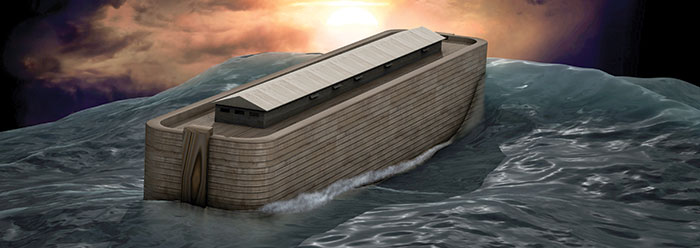Where are the fossils from the people who lived before the Flood? A 1992 ICR article supplied seven responses to this question.1
- Land animals and humans have a low fossilization potential. We would expect few fossils from them.
- If the Flood buried a multitude of people and distributed their bodies among the world’s sedimentary rocks, finding even one human fossil in such a vast area would be unlikely.
- Underwater mudflows during the Flood would have ground human bones to powder.
- Floodwaters receding off continents might have likewise pulverized them.
- Catastrophic geological processes may have buried ancient continents in their entirety, virtually erasing all evidence of people.
- Whoever discovers a pre-Flood human bone or bone fragment might not identify it as such, since that finding would not fit evolutionary expectations.
- The pre-Flood population might have been quite small, considering Genesis 6:13’s statement that “the earth was filled with violence.”
Does any new evidence help to update these responses?
Fossilization, Runoff, and Pennsylvanian Coal
Low fossilization potential refers to the rarity of fossil formation because unique conditions are needed to preserve fragile remains. The Flood supplied those conditions, though. If humans have low fossilization potential, wouldn’t land animals, too? Paleontologists have created online databases that map fossil land animal locations, sortable by geologic layering. Flood fossils formed in specific layers or in certain pockets where slowing sedimentary slurries transported plant and animal wreckage to a stop. They were not spread evenly around the world. So, in general, we know where to expect land mammal fossils, and they contain no undisputed human remains.
What about underwater mudflows? New earth science studies confirm that unimaginably catastrophic geological processes really happened.2 Crustal plate motions would have produced numerous underwater mudflows. But because pre-Flood people presumably did not live on sea floors, we should not expect underwater mudflows to have ground up any people or large land mammals.
Waters racing off the continents in the later months of Noah’s Flood could also have pulverized people and animals. Since 1992, creation geologists have searched for rocks that show a clear pre-Flood/post-Flood boundary, but experts remain divided. If fossils found right above dinosaurs represent post-Flood deposits, then the Flood fossilized very few land mammals like deer or dogs. In that case, floodwater runoff may have ground them all to powder or transported them unburied until they rotted. However, if many of the land animal fossils found above dinosaur layers represent late-Flood deposits, then these represent human-free, pre-Flood animal remains possibly buried by floodwater runoff. This again leaves the question of what happened to the humans unresolved. More research may help discern the better of these options.
Although we know of no undisputed human skeletal remains in Flood rocks, a few unique artifacts may have come from pre-Flood humans. These include an iron cup discovered in 1918 inside a lump of Pennsylvanian coal from Oklahoma, a brass bell inside a lump of West Virginia coal, and in 2013 an aluminum gear section in another Pennsylvanian coal mined in northern Mongolia.3 Although these artifacts are intriguing, we need more thorough investigations that test against fraud before building a case on them.
Evolutionary Bias
What would a scientist who was convinced that modern-looking humans did not evolve until 2.5 million years ago think of a human fossil found in layers assigned to three or more million years? An answer came in 2011, when researchers demonstrated that a fossil foot bone exactly matched human anatomy. However, since its evolutionary age was just over three million years, they “concluded” it was from an evolutionary ape-like human that had an ape’s body but a human foot.4 Of course, the human bone was not attached to or associated with any other bones—let alone ape bones. This and other examples give good reason to doubt that evolutionary researchers can weigh evidence objectively enough to ever admit to finding human fossils where they wouldn’t expect them. Maybe there are human fossils mixed in ancient bone beds, and they simply go unreported or misidentified.
Worldwide Violence and Population Decline
Genesis 6:5 says of the pre-Flood world, “Then the LORD saw that the wickedness of man was great in the earth, and that every intent of the thoughts of his heart was only evil continually,” and verse 11 says, “The earth was also corrupt before God, and the earth was filled with violence.” Everywhere was bad—as bad as people can possibly get. Could the homicide rate have been so high that it curtailed or reduced the pre-Flood population?
We have a modern example. In 1956, Waorani tribesmen brutally murdered missionaries Nate Saint, Jim Elliot, and three others in the jungles of Ecuador, demonstrating their reputation for extreme violence.5 Generations of intertribal murder raids whittled their numbers down to a pitiful band of 500.6 But many Waorani listened to the gospel presented by the wife and sister of two of the murdered missionaries. Warlike behavior evaporated as former murderers and new generations began trusting and following the living Lord Jesus. Their population today approaches 2,500. Clearly, unchecked violence can shrink populations.
Also, Jewish tradition from the Book of Enoch, part of which appears to be quoted in Jude 1:14-15, says that perhaps most of the pre-Flood people murdered one another. We shouldn’t lean too heavily on this for historical details, but we can lean on Scripture. It says the violence was so extreme it deserved worldwide judgment. Exceedingly high murder rates could have whittled down the ancient population, but Matthew 24 confirms that some still lived. In verse 39 Jesus said, “The flood came and took them all away.”7 The fewer their numbers, the less likely any fossils would be found.
Where Are Evolution’s Fossils?
Dr. John Morris wrote in 1992:
If evolution is true, and humans have lived on Earth for three million years, many trillions have lived and died. Where are their fossils? This is the more vexing question.1
What have we learned since then? That not only are evolution’s human fossils still missing, but so is any other trace of their existence. Countless human bones should fill caves, crevices, and graveyards. Their ancient firepits and trash heaps should be found around every corner. Scientists have described a few extinct ape fossils and evidence of unfamiliar-looking humans, but their continued failure to find the human fossils expected from millions of years of evolution only intensifies this “more vexing question.”
Since 1992, archaeologists exploring ancient human civilizations have marveled at exquisite carvings, recorded amazingly detailed paintings, and uncovered expert architecture like that at Göbekli Tepe in Turkey. None of these artifacts belong to the evolutionary story’s apelike pre-civilized humans. Instead, they spring up suddenly in human history, revealing that our first ancestors had at least as much intelligence and abilities as we have. It’s as though our original forefathers stepped off a ship into the Middle East with no evolutionary backstory. According to Genesis, Noah’s grandsons built a new society immediately after the Flood. So the near-absence of human fossils refutes human evolution and confirms what the Bible says about Noah’s descendants.
Where are all the pre-Flood human fossils? Well, the high murder rates that Genesis 6 suggests, plus other factors like catastrophic flooding, floodwater sorting, and even investigator bias, indicate we might not expect to find many after all. Meanwhile, evolution’s expected pre-civilization human fossils remain missing.
References
- Morris, J. 1992. Why Don’t We Find More Human Fossils? Acts & Facts. 21 (1).
- Clarey, T. 2014. Runaway Subduction and Deep Catastrophic Earthquakes. Acts & Facts. 43 (1): 18-19.
- Thomas, B. Possible Human Artifact Found in Coal. Creation Science Update. Posted on icr.org February 20, 2013, accessed September 2, 2015.
- Ward, C. V., W. H. Kimbel, and D. C. Johanson. 2011. Complete Fourth Metatarsal and Arches in the Foot of Australopithecus afarensis. Science. 331 (6018): 750-753.
- “The Waorani have been considered as the most warlike society yet described owing to exceptionally high homicide rates.” Cardoso, S., et al. 2012. Genetic uniqueness of the Waorani tribe from the Ecuadorian Amazon. Heredity. 108 (6): 609-615.
- Beckerman, S., et al. 2009. Life histories, blood revenge, and reproductive success among the Waorani of Ecuador. Proceedings of the National Academy of Sciences. 106 (20): 8134-8139.
- Matthew 24:39.
* Mr. Thomas is Science Writer at the Institute for Creation Research.






















